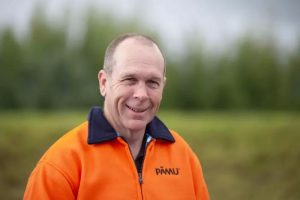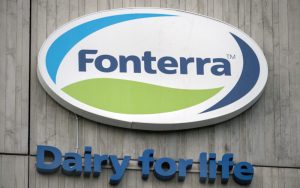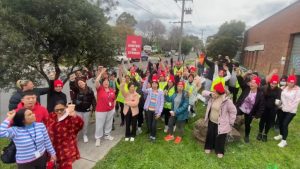
Chris and Carla Staples bought their first farm four years ago and it looks immaculate. New shedding has been added, the dairy exterior looks swish and nearly half the 103 hectare (effective) farm has been regrassed. It has all been accomplished from cash flow, in line with their strategy throughout sharemilking and now farm ownership to focus on reducing debt and only spending money when there’s surplus in the wallet.
The couple always hung on to their long-term goal of farm ownership, despite the naysayers along the way who told them they were dreaming.
From a year working on a farm, Chris progressed to four years as a manager and then as a couple with two young kids they took on a lower-order sharemilking contract for four years, followed by seven years in a 50:50 contract.
“There’s a lot of work to get to farm ownership,” Chris says. “To get there you need to have made the decision early on in your career and have clear goals and a pathway to achieve it.”
Milking 360 cows at Whataroa in southern Westland, they won the West Coast-Top of the South Sharemilker of the Year competition in 2014. Winning that competition made them more aware of what they could achieve and that were heading in the right direction for farm ownership.
“We wanted farm ownership and we were strategic in our savings programme,” Carla says. “We’ve always done the work ourselves rather than get staff in – if we could do it.”
Whenever they had extra money they were either buying stock to build up equity or repaying debt. Then four years ago, late in the season, a farm they thought would never be available came on the market at Kowhitirangi in the lush valley inland from Hokitika. It was a difficult time to buy a first farm. Banks were increasingly cautious about lending, especially to first farm buyers. But Carla says their Dairy Industry Award success definitely gave the bank more confidence about their forecasting.
“Our cash flows were always good and when we were buying a farm we could prove we could make money and pay off debt.”
Westland Milk Products was still a co-operative and payout for the 2018-19 season was between $5.80 and $6/kg milksolids (MS). A year later the Staples were milking for Yili after it bought the co-operative, with a 10-year guarantee to match Fonterra’s farmgate milk price, plus the purchase of shares.
For first-farm buyers budgeting on the co-operative’s payout which had been challenging for years, Yili was a lucky break. The cash payment of $3.41 per share went straight into debt reduction and their budgeting suddenly had a higher payout to work with.
They describe West Coast dairy farms as value for money. They have a price tag that is about a third of Canterbury dairy farms and don’t have the cost of irrigation. Production is about half, but overall the return on investment is greater. In Chris and Carla’s view, the West Coast is a good return on investment.
Four years after buying their first farm, they don’t have huge debt which means they are not stressing too much about increasing interest rates, despite being on a floating rate. It’s a risk factor, says Carla, but they are comfortable with that risk.
Each season they have a baseline budget for the business and if the payout is higher than expected, that is a bonus they will use to reduce debt first and then make improvements to their assets. By doing that, they aim to have more flexibility and fat in the business to cope with the unpredictability of payout, climate and government policies.
The Staples had saved hard over the years to achieve their goal and to get the extra equity they needed for the purchase of the farm, they sold 160 of their cows, keeping the young stock with the best genetics in their herd. They had the scope as they were moving from a 360-cow herd to a farm that had been milking 230 Jersey cows.
Their own cows are Friesian crossbreds and so they have dropped numbers to 205 to compensate for Friesian-type cows on the heavy soils. It also fits their philosophy of fewer cows for more production. They begin the season on twice-a-day milking, dropping to 3in2 about March to lengthen the round and then once-a-day for the last month to build up condition and feed going into winter.
With limited inputs and pasture production about nine tonnes drymatter (DM)/ha/year, they reached 880kg milksolids (MS)/ha during the 2020-21 and 430kg MS/cow. This past season it was back a bit to about 410kg MS/cow after a particularly wet spring and ended up with a total of 84,000kg MS which is down a bit on their best season of 89,000kg MS from 210 cows.
In the past four years, Carla has detailed much of their progress through their Dairy Exporter’s Milking Platform column – and they have accomplished a lot. Apart from buying the farm, they have baulked at taking on more debt and everything has been done from cash flow. Though they recognise that down the track if they have to make a big purchase such as a new tractor, that won’t come out of cash flow.
Regrassing programme
In their first season, they upgraded the dairy building, including a new roof, cleared drains and subsoiled a lot of the farm to aerate and drain the fertile, but heavy soils. The effluent pond was enlarged to 600,000 litres and they began a major regrassing programme, much of it following the winter swede crop that is used to keep the cows at home. Much of the farm had not been regrassed for 20 years and regrassing is their way of becoming less reliant on imported feed.
In their regrassing programme they have trialled various ryegrass-clover mixes and this past season they have sown 10ha of the tetraploid ryegrass Forge, plus the diploid, Maxsyn, with a couple of different white clovers. It is more regrassing than they planned this year, but after the wet spring, they had a great summer and decided to keep regrassing while the going was good.
“It made us a bit short of feed in early autumn, but we’re fine now as the new grass has really taken off,” Chris says.
He likes to try the newer pasture species to find out what works best on the farm. The Italian ryegrasses weren’t lasting and he has high hopes for Forge. It is a new hybrid that is hard to source after a poor harvest of the seed in Canterbury, but they have enough to also sow this winter’s swede crop back into pasture.
Paddocks are sprayed out and fully cultivated before regrassing and are drilled using their own seed drill. They have purchased all of their own equipment as the weather can often restrict the time available to get the job done. Most of the farm has been aerated in their four years of ownership to help drainage and reduce compaction.
In their first year on the farm, they soil tested every paddock which showed up a few areas that needed attention and fertilised each paddock according to the results. Last year they tested the entire farm again and the results showed the benefits of targeted fertiliser applications.
“It saves you money in the long run because you aren’t applying any more fertiliser than you need,” Carla says.
Last spring was so wet they couldn’t drive over the paddocks for a month and had to spread DAP over the farm by helicopter. It only took 45 minutes to get fertiliser on which Carla says was great for time management, but another cost. A high-rainfall climate means applying fertiliser little and often, including their nitrogen applications which are on target for the 190kg/ha/year cap.
They have also used the plant-growth regulator ProGibb SG which has enabled them to halve the nitrogen applications in April and May. Chris premixes ProGibb and sprays it on the pasture, so it is a bit of work, but it is only for two months of the year and it gives the pasture a good boost for winter grazing.
Cows graze on grass and a break of the 6ha of swedes through winter with the swede crop yielding 16-18t DM/ha. If it gets wet in autumn, Chris says they start feeding the cows on the crop in May to build their condition going into winter.
They also make wet silage on the farm to feed to the cows whenever they need it through the year and this past season they made 210t to feed out on the concrete feedpad.
They have looked at putting a roof over the feedpad, but at this stage feel it would over-capitalise the small farm. Troughs on the feedpad enable them to feed an imported feed such as palm kernel if required.
Chris says they buy in feed if it is needed, but don’t want to be reliant on it, especially with rising costs. Like the price of fertiliser which has soared in the past season – doubled for the Staples – the price of palm kernel has risen dramatically. Since October it has risen from $300/t to $500/t for them. Though they still intend to feed some palm kernel through the year, it won’t be as much as the 100-150t per year they have been feeding between April and October. That covers preparation for calving and then mating.
Throughout the season, the cows are fed molasses in the dairy which helps cow flow and gives the cows extra energy when the weather is cold and wet.
Before the increase in palm kernel costs, supplements cost them 84c/kg MS for the 2020-21 season and that included making silage, calf feed, palm kernel and molasses.
It was part of their farm working expenses that tallied a moderate $3.73/kg MS – with this season still to be worked out and expected to increase due to higher costs of just about everything.
“We are really honing in on everything and being careful of what we spend,” Carla says.
Better calves with ad-lib milk feeding
The Staples have never been afraid of trying something new and last season Carla decided to give the calves ad-lib access to milk. It meant the calves drank 70% more milk, but they grew faster and were weaned three weeks early.
“Seventy per cent more milk sounds phenomenal! But we had better calves that were quieter because it was like being reared by their mothers.
“When you typically go to a calf shed in the morning they are all going for it, but when they are ad libbing there’s absolute silence.”
The calves were fed whole milk that wasn’t destined for the vat, such as milk from the previously teat-sealed heifers. The calves were kept inside as long as possible, which was about five weeks, then transitioned on to the calfetaria in the paddock which took about three days. By early November they were all weaned because they had reached 90kg liveweight and that saved money on meal.
“The key for ad-lib feeding is never let them run out of milk. I always go over in the morning and top it up and then again in the afternoon. It’s a lot easier and time wise it’s a lot better. I had a pen of newbies so I could teach them to drink and then it’s just making sure they look like they have had a feed. They don’t overfeed because it’s more natural.
It worked so well Carla intends to ad-lib feed the calves again this coming season. The calves stay on the farm until May 1 and through autumn where they have ad-lib access to the latest paddocks of new grass. By the time they head down to a grazier at Whataroa, they are huge. The same day, the in-calf heifers return to the farm for winter where they graze with the main herd. Chris says it gives the heifers time to adjust to the herd before the season begins.
“We put the whole lot through the shed once a week in winter and check their teats and teat spray and sometimes just let them walk through the (24-aside herringbone) by themselves.”
Three seasons ago they began teat sealing the heifers to avoid mastitis. The heavy soils on the farm are great for holding moisture through summer but resulted in more mastitis cases in the spring due to their 4m-plus annual rainfall. Teat sealing has helped eliminate mastitis and its associated losses.
“It’s a nightmare of a job though. We do it when it has been dry for a while so the heifers are nice and clean. You have to be really careful about hygiene and we use lots of methylated spirits.”
“Fun times in the shed,” Carla adds.
Then at calving, each teat has to be stripped to completely remove the seal. It’s a hassle and a cost to teat seal each heifer, but Chris says the cost pales in comparison to possibly losing heifers from spring mastitis or having to cull because of lost quarters for the same reason.
The heifers calve toward the end of July, about 10 days before the rest of the herd so there’s a bit of time to “muck around with them” in the dairy before the rest of the herd calve and time is short.
Chris and Carla employ no labour, with a relief milker only brought in when they are away, so early spring is full on.
This season they have extended their calving to 10 weeks to get more cows in calf but will still have the same calving spread by using semen from short-gestation bulls for the last eight days of mating. They are strongly driven by breeding worth (BW) and production worth (PW), always nominating a bull to a particular cow to improve genetics in the herd. They reason that it isn’t a big cost to nominate a bull and you get what you want. Any cows they don’t want replacements from get Hereford straws at AI. The Hereford straws ensure a market for the calves and fewer bobby calves, with the same buyers taking their Hereford-cross calves for the past eight years.
The heifers have been artificially inseminated for the past eight years to improve genetics. This year they went one step further and used sexed semen for 75% of the heifers after a double PG programme and 60% of those resulted in successful pregnancies. They used frozen sexed semen which doesn’t get results as high as using fresh semen, but the heifers were in Whataroa so frozen semen was the only practical way of doing it.
“It costs about $55 for the sexed semen compared with about $25, but you only need one more heifer on the ground and it’s paid for itself,” Chris says. They aim at 50 heifer replacements a season which gives them good selection pressure for genetic gain and a younger herd.
Bulls go over the cows that are still cycling after five weeks of AI and that results in a small number of bobbies. They have looked at Hereford sexed semen to create more bull beef calves, but have decided to carry on the way they are for now. Carla says they are always looking at ways to improve everything they do, so they will keep their eye on options.
For the past two years the herd has had no intervention at mating. Cows are tail painted as they calve with different colours for each calving batch and that helps identify calving dates for then being metrichecked for uterine problems. Post insemination they then rely on Estrotect heat detection patches and that tail painting to identify any cows recycling. This season they also used teaser bulls to help identify cycling cows.
Now that they have a smaller herd and there are just the two of them onfarm, they feel they have more consistency in identifying cycling cows and can record all natural matings after AI. When the cows are pregnancy scanned they also establish the age of the calf so they know whether the AI was successful or whether it was a pregnancy from a bull. Mating is an area they are always trying to make improvements by tweaking different things but mother nature sometimes has other ideas.
They’re happy with the way the season finished up though, considering the severity of spring and are now working on preparing the herd for calving and next season. As the farm improves and their debt goes down, they reckon it can only get better.
























